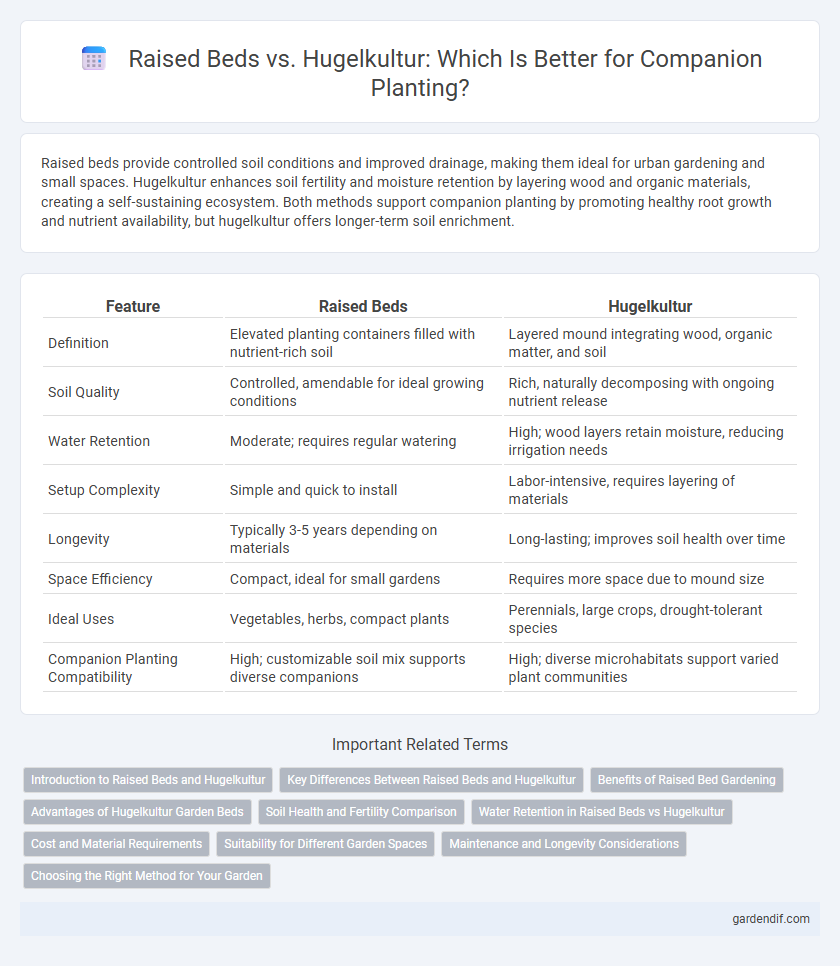
Raised beds vs Hugelkultur Illustration
Raised beds provide controlled soil conditions and improved drainage, making them ideal for urban gardening and small spaces. Hugelkultur enhances soil fertility and moisture retention by layering wood and organic materials, creating a self-sustaining ecosystem. Both methods support companion planting by promoting healthy root growth and nutrient availability, but hugelkultur offers longer-term soil enrichment.
Table of Comparison
| Feature | Raised Beds | Hugelkultur |
|---|---|---|
| Definition | Elevated planting containers filled with nutrient-rich soil | Layered mound integrating wood, organic matter, and soil |
| Soil Quality | Controlled, amendable for ideal growing conditions | Rich, naturally decomposing with ongoing nutrient release |
| Water Retention | Moderate; requires regular watering | High; wood layers retain moisture, reducing irrigation needs |
| Setup Complexity | Simple and quick to install | Labor-intensive, requires layering of materials |
| Longevity | Typically 3-5 years depending on materials | Long-lasting; improves soil health over time |
| Space Efficiency | Compact, ideal for small gardens | Requires more space due to mound size |
| Ideal Uses | Vegetables, herbs, compact plants | Perennials, large crops, drought-tolerant species |
| Companion Planting Compatibility | High; customizable soil mix supports diverse companions | High; diverse microhabitats support varied plant communities |
Introduction to Raised Beds and Hugelkultur
Raised beds provide controlled soil environments that improve drainage and root growth, ideal for gardeners seeking efficient space utilization and soil management. Hugelkultur incorporates decomposing wood and organic matter into mounded beds, enhancing moisture retention and soil fertility through natural decomposition processes. Both methods offer sustainable gardening solutions but differ in structure, materials, and long-term soil health benefits.
Key Differences Between Raised Beds and Hugelkultur
Raised beds consist of soil contained within a framed structure, providing controlled growing conditions and improved drainage, whereas hugelkultur uses decomposing wood and organic matter piled to create nutrient-rich, moisture-retentive mounds. Raised beds require added soil amendments and regular watering, while hugelkultur beds naturally enhance soil fertility over time through wood decomposition and retain moisture for extended periods. Key differences include construction materials, water retention capabilities, and the long-term soil-building process inherent to each method.
Benefits of Raised Bed Gardening
Raised bed gardening offers enhanced soil drainage and superior control over soil quality, promoting healthier root development and higher crop yields. This method minimizes soil compaction and improves access for planting, weeding, and harvesting, making garden maintenance more efficient. Raised beds also extend the growing season by warming earlier in spring and provide effective pest management by creating physical barriers against common garden pests.
Advantages of Hugelkultur Garden Beds
Hugelkultur garden beds offer superior moisture retention due to their wood-based core, reducing irrigation needs compared to raised beds. The decomposing wood releases nutrients gradually, promoting long-term soil fertility and healthier plant growth. These beds also improve soil aeration and support beneficial microbial activity, enhancing overall garden productivity.
Soil Health and Fertility Comparison
Raised beds offer improved soil drainage, aeration, and controlled nutrient levels, making them ideal for maintaining consistent soil health. Hugelkultur enhances soil fertility by decomposing woody material over time, increasing organic matter and water retention, which benefits long-term soil vitality. Both methods promote robust soil ecosystems, but Hugelkultur provides ongoing nutrient release, while raised beds allow for easier soil amendments and management.
Water Retention in Raised Beds vs Hugelkultur
Raised beds provide moderate water retention by using well-draining soil mixes that prevent waterlogging but may require frequent irrigation during dry periods. Hugelkultur excels in water retention due to its decomposing wood layers that act like a sponge, absorbing and slowly releasing moisture, reducing the need for supplemental watering. This makes hugelkultur especially beneficial in drought-prone areas or for gardeners aiming to conserve water while maintaining raised planting areas.
Cost and Material Requirements
Raised beds require purchasing or sourcing quality soil, wood, and sometimes liners, leading to higher upfront costs compared to Hugelkultur, which utilizes decomposing wood and organic matter mainly gathered from natural sources, making it more cost-effective. Material requirements for raised beds involve treated lumber or durable materials that need regular replacement, whereas Hugelkultur relies on logs, branches, and compostable materials that break down over time, enriching the soil. Hugelkultur's reliance on on-site natural resources minimizes expenses, while raised beds might require continuous investment in soil amendments and structural maintenance.
Suitability for Different Garden Spaces
Raised beds offer versatility and are ideal for small to medium-sized garden spaces, providing excellent soil control and drainage. Hugelkultur, which uses decomposing wood and organic matter, suits larger garden areas where space and natural resources are abundant, promoting long-term soil fertility and moisture retention. Choosing between the two depends on garden size, available materials, and desired maintenance levels.
Maintenance and Longevity Considerations
Raised beds require regular soil replenishment and weeding to maintain optimal plant health, with lifespan dependent on wood decay and soil quality, typically lasting 5 to 10 years. Hugelkultur beds, built from decomposing wood and organic matter, improve soil fertility over time while requiring minimal maintenance but may settle unevenly over several years. Longevity in hugelkultur can extend beyond a decade due to the slow breakdown of woody material, providing sustained moisture retention and nutrient cycling with reduced upkeep.
Choosing the Right Method for Your Garden
Raised beds provide optimal soil control and drainage, ideal for gardeners seeking easy access and quick planting cycles. Hugelkultur enhances soil fertility and moisture retention by layering decomposing wood and organic matter, suitable for sustainable, long-term growth. Selecting between raised beds and hugelkultur depends on garden space, maintenance preference, and desired soil ecosystem benefits.
Raised beds vs Hugelkultur Infographic

 gardendif.com
gardendif.com